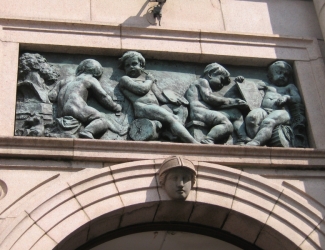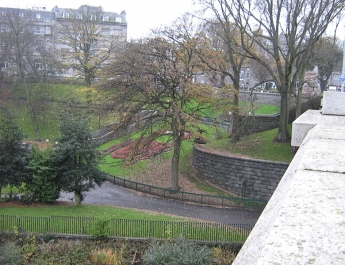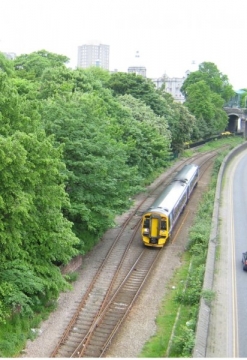Controversy has raged over the fate of Union Terrace Gardens for the last three years. A major subtext to this has been the role of culture in Aberdeen life, particularly in view of the way the proposed Peacock Visual Arts centre for contemporary arts was gazumped by Sir Ian Wood’s Civic Square proposal in 2008, writes Mike Shepherd.
The £13.5m building was to contain a gallery, TV studio, print studio, restaurant and offices for Peacock Staff and provide a base for Aberdeen City Council’s Arts Development and Arts Education teams as well as extra space for the City Moves dance agency.
It was to be called the Northern Lights Contemporary Arts Centre.
When the Civic Square was first mooted, the emphasis was on the Square itself. Sir Ian Wood had described it as:
“a cross between the Grand Italian Piazza and a mini Central Park”.
http://www.eveningexpress.co.uk/Article.aspx/935798?UserKey
An underground concourse was also proposed and at this stage, the main uses were identified in a Press & Journal report:
“The new square could have three underground levels, the first of them offering the potential for Peacock Visual Arts’ planned new centre, as well as restaurants, a heritage museum and visitor attractions linked to north-east attributes such as granite, paper, fishing, whisky and golf.”
http://www.pressandjournal.co.uk/Article.aspx/1259519
However, Peacock Visual Arts were understandably reluctant to be included within the Civic Square plans. In any case, an underground concourse would not be a suitable venue for an arts centre. A building receiving natural light would have been much more appropriate.
Sir Ian, perhaps frustrated at the reluctance of Peacock to get involved, told the Herald Scotland
“There is quite rightly a strong feeling about the arts in Aberdeen,” he says. “It is not for everyone but some people do feel intensely about it. I understand the emotional concern.
“What I find hard is that, frankly, this is about jobs and economic prosperity, for the wider interests of people in Aberdeen who don’t care about the arts. Eighty per cent of the people who spend time in the square will have no interest in the arts. You have to develop things for the good of everyone.”
http://www.heraldscotland.com/news/home-news/art-student-versus-millionaire-in-a-battle-for-a-city-s-heart-1.929558
Peacock’s arts centre was effectively killed off by the Aberdeen Council vote in May 2010 to progress instead Sir Ian Wood’s Civic Square proposal. This was later rebranded the City Garden Project.
Following the demise of Peacock, ACSEF started to develop an increasing interest in local culture. ACSEF are the non-elected body charged by both Aberdeen and Aberdeenshire Councils with promoting the economic development of the region. They have been involved in promoting the City Square, describing it as one of their flagship projects.
The ACSEF minutes for the 4th October 2011 noted comments by Professor Paul Harris, the recently appointed head of Robert Gordon University‘s Gray’s School of Art in Aberdeen :
“Paul Harris advised that he is a member of the Scottish Enterprise Tayside Regional Advisory Board. At a national level he had been closely involved in taking forward the V&A project which illustrates how a collective vision could be translated into strategy and raise a city’s profile in an international context.
“Creative industries have an important role not only in their own right but also in terms of being key drivers of an area’s wider economic success in part through creating vibrant and attractive communities in which to live, work and visit and in fostering innovation, a key driver of economic success.
“Professor Harris concluded that the vibrant and valuable creative industries sector in Aberdeen City and Shire requires greater cohesion and visibility and suggested that a creative industries strategy be devised to address this and realise the sector’s potential for future growth. In addition projects such as the City Garden offer opportunities for the city to achieve an international cultural venue. He suggested that a collective approach amongst partners could be achieved at no cost while a strategic voice supports funding bids.”
Some in the city might feel alarmed about the business–dominated board of ACSEF defining a top-down strategy for the “creative industries” in the Aberdeen area.
The link to the City Garden Project is of note. Paul Harris is mentioned in the news section for the City Garden Website – “City Garden Project Can Make Aberdeen Cool, Contemporary and Cultural”.
“Professor Harris is leading a City Garden Project sub-group representing culture, the arts and the creative sector to consider the potential content for the scheme which has a new centre for culture and the arts at its heart.
He added: “The V&A in Dundee is a perfect example of culture being a catalyst for wider regeneration. There we had an idea and had to develop the infrastructure. In Aberdeen we have the potential infrastructure and a unique opportunity to fill it creatively.
The sub-group is proposing a new model to enhance the performance and reputation of the region’s arts and culture locally, nationally and internationally based around the new infrastructure the City Garden Project can deliver above and below ground.
The vision is to create an internationally known facility that is a focal point for exchanging and showcasing excellence in cultural activities between countries, regions and cities located around the North Sea.
The so-called “Northern Arc” would form partnerships with key cultural organisations to present displays and exhibitions, diverse performances and events covering, history, science & technology, visual arts, design, film, music, dance and literature.
“The Northern Arc” will include a number of flexible spaces, centred in the City Garden, with on-going programmes of events and activities with a variety of local, regional and international organisations”
http://thecitygardenproject.com/news_full.asp?id=95&curpage&search=clear§ion=news
The use of the name “Northern Arc” is unfortunate given that the City Garden Project had killed off the Peacock Visual Arts plan to build the “Northern Light” contemporary arts centre. The sub-group mentioned is believed to include most of the city’s existing arts organisations, which are largely publicly funded. If the underground concourse is built, could it be that existing facilities such as the Belmont Cinema and the Lemon Tree will be relocated to the building?
The Press and Journal reported last October that Aberdeen Council is interested in making a bid for Aberdeen to become the UK City of Culture in 2017.
“Council bosses are applying for a £92 million loan from the Scottish Government to fund five regeneration schemes, including the controversial City Garden Project. Approval of the ambitious plans could trigger a campaign for the prestigious title, officials confirmed yesterday.”
http://www.pressandjournal.co.uk/Article.aspx/2488524
The bid to become city of culture could prove a hard sell to the people of Aberdeen. It was actively discussed with much scepticism on the Aberdeen Facebook page. Here are some of the comments:
– Aberdeen has plenty of culture. What it doesn’t have is a council that knows what culture looks like. Culture is one of the indicators of true prosperity but you can’t make money off it directly. The council’s thinking process seems to be: Step 1 – culture, Step 2 – ???, Step 3 – Money!
– I will say that there are signs of some joined up thinking re culture. A sign though… It’s not for the council to lead and make it happen though. It should come from the ground up to the point where the council starts listening to those that are doing and asking what is needed rather shoving another box ticking lecturing strategy in our faces. Far more people working across the arts know what is needed than there are people sitting at desks re writing old words. The city would need to give a decent amount of funding to Arts organisation and to arts within education instead of cutting funding almost to the point of extinction.
– So much negativity in this thread, Aberdeen should be ambitious & go for this city of culture in 2017, Aberdeen despite is geography has lots of people doing innovative things in the arts. It did Liverpool no harm & only positives came out of it…
A group called AB+ is organising a cultural conference in the Arts Centre on 26 January. Two of the speakers are Professor Paul Harris and Valerie Watts, Chief Executive of Aberdeen City Council.
“Valerie will be describing her experiences in Northern Ireland with Londonderry’s bid to become European Capital of Culture and the impact this had on the arts there, whilst Paul will talk about bringing the V&A to Dundee.”
http://positiveaberdeen.wordpress.com/2011/12/21/conference-speakers-announced/
The conference is an opportunity to discuss cultural activities in Aberdeen and as such is to be welcomed. It is likely that some of the issues raised here will be touched upon by the speakers in the Arts Centre.
The City Garden Project will be launching its referendum campaign and will also soon be announcing the final chosen design. It is almost certain that the campaign for the City Garden Project will tie together local cultural activity, economics and Aberdeen City Council’s bid to become UK City of Culture for 2017.
It’s an explosive mix.




